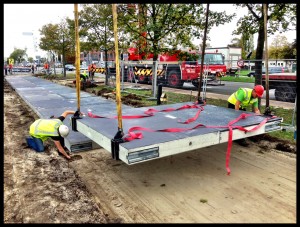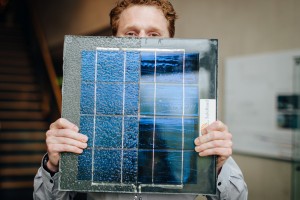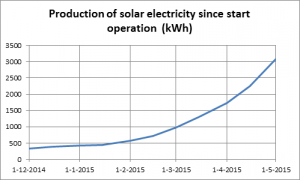Converting Roads into Solar Panels

A Dutch start-up has found a way to transform the whole road network into an enormous source of green energy. SolaRoad produces concrete modules that can capture sunlight and transform it in energy for street lighting, traffic systems, households and electric vehicles. The pilot has already been tested in a cycle path. The Province of Noord-Holland, Ooms Civiel and Imtech have formed a consortium to develop SolaRoad’s technology and reach an energy-neutral mobility system.
In the Netherlands only, roads occupy 450 km2. SolaRoad founders had a vision where all the sunlight energy falling on that vast surface could be harvested and used to power vehicles. Since then, they have been working to develop the technology to produce concrete modules that can be assembled to form roads.
After making sure that the project was technically and economically feasible, the first tests were carried out in a laboratory. The pilot was a tipically Dutch cycle path, much more feasible and convenient that a highway; at the same time, research in several other elements (heat, cold, salt…) was taking place in the lab.
Technology and performance
SolaRoad’s technology consists of prefabricated concrete modules of 2.5 x 3.5 m with a 1 cm thick top made of tempered glass. Under the glass, crystalline silicon solar cells capture the sunlight. The electricity can then be transported to the grid and used for several purposes. Smart ICT applications will help distribute the energy production at peak and dip times. The top layer must have several characteristics: strong enough to resist the weight of the cars; translucent and dirt-repellant to allow light to pass through. In the cycle path pilot, a skid resistant coating has been added to the surface. Road construction avoids damage to the soil underneath, and the design avoids contraction and expansion due to temperature changes. The glass can resists big impacts, but in case of breakage, the glass pieces remain in place thanks to the coating, and can be cycled on until repair.
SolaRoad is an example of decentralized energy production and distribution. Energy can be distributed from the panels to the street lighting, the electric bicycle charging or the grid, depending on the needs. This year, SolaRoad released a press kit stating that the energy production was higher than expected during the first six months of the pilot phase. The bike lane generated 3,000 kWh, enough to provide electricity for a one-person household for a year. They expect to obtain more than the 70 kWh per square meter per year they predicted in the lab as an upper limit.
Source: SolaRoad



